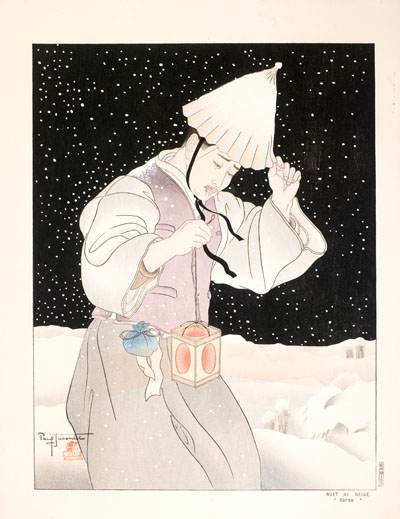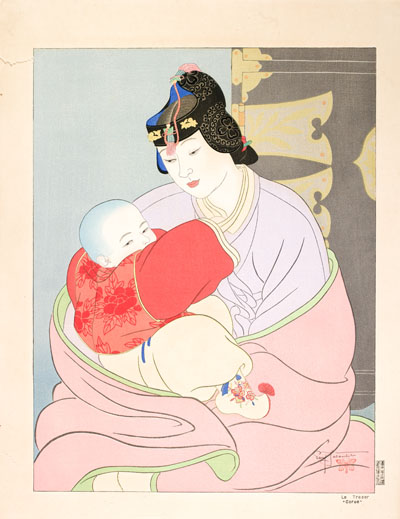Between 1910 and 1945, Korea was under Japanese control and its capital city, Seoul, became known as Keijo. Jacoulet visited Korea on numerous occasions, especially after 1929, when his mother moved there with her new husband, a Japanese physician.
Jacoulet depicted Korean subjects, young and old, male and female, in more than thirty-five prints. These include a range of subjects such as scholars, priests, beggars, mothers with their children, portraits of wealthy young Koreans, and workers such as potters, pastry cooks and laundresses. Jacoulet’s goal in producing these color woodcuts was to capture the beauty, everyday activities, and traditional and contemporary dress of real people from around Asia.
|
Nuit de Neige. Corée (Snowy Night. Korea)
1939 Color woodcut print Page size: 18 3/4 x 14 1/4 in. (47.6 x 36.2 cm) Image size: 11 3/4 x 15 1/2 in. (29.8 x 39.4 cm) Collection of Dorothy Finkin, courtesy of Eugene Finkin © 2012 Artists Rights Society (ARS), New York / ADAGP, Paris
One of Jacoulet’s most popular prints, Nuit de Neige depicts a typical Japanese ukiyo-e theme. The print includes gofun, or ground oyster shells, to articulate the snow falling against the dark sky, and gauffrage, small embossing blocks, to suggest light emanating from the lantern. The presence of a contemporary landscape in the lower right corner is rare in Jacoulet’s oeuvre. Nuit de Neige also appeared in a smaller greeting card format that was sold as a set along with three other miniature prints, known as surimono. The proceeds from the sale of these greeting cards went directly to the families of the woodblock printers. These funds were sufficient enough to buy Tokyo homes for two of the printers who worked regularly with the artist. |
Le Tresor. Corée (The Treasure. Korea)
1940 Color woodcut print Page size: 18 3/4 x 14 1/4 in. (47.6 x 36.2 cm) Image size: 11 3/4 x 15 1/2 in. (29.8 x 39.4 cm) Collection of Dorothy Finkin, courtesy of Eugene Finkin © 2012 Artists Rights Society (ARS), New York / ADAGP, Paris
The subject of a mother cradling her young child is a common theme in European art and would have been of interest to Jacoulet’s western audiences. Jacoulet’s choice of theme also reflects his interest in the prints of Kitagawa Utamaro (1753–1806), one of the most prolific artists of the Japanese ukiyo-e tradition, who was very interested in images of mother and child. Le Tresor was one of Jacoulet’s most popular prints, selling more than 300 copies by 1941. |





